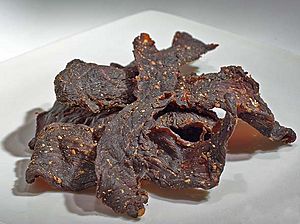Sukuti facts for kids
 |
|
| Alternative names | Dried meat |
|---|---|
| Course | Snacks |
| Place of origin | Nepal |
| Main ingredients | Buffalo, lamb and goat |
Sukuti (Nepali: सुकुटी) is a type of dried meat from Nepal. People also eat it in the Himalayan areas of India and Tibet. It is often made from buffalo meat. Sometimes, it is made from lamb or goat.
Sukuti is a very important dish for the Limbu and Gurung communities. In the Limbu language, it is called Sakhekya. Long ago, people used sukuti to get protein and to have different foods during the cold winter months in the mountains. Today, food is easier to find all year. So, sukuti is now a special treat that people can enjoy anytime. It is one of many meat dishes in Nepal. You can fry it or cook it in many other ways.
Why was Sukuti important?
In the past, people in Nepal did not always have a lot of meat. They would make sure to use every part of an animal. Drying meat was a smart way to save it for later. This was especially helpful during tough winters when fresh food was hard to get. Dried meat like sukuti became a must-have food. Now, it is a popular and tasty dish.
How is Sukuti made?
To make dried meat, people cut meat from any animal or bird into thin strips. They carefully remove any fat. The meat strips are then hung up, often above a Chulho (a wood fire). The smoke from the fire helps to dry the meat.
Sometimes, the smoke could give the meat an unwanted smell. To fix this, people often put spices on the strips. These spices include salt, cumin, pepper, chilli powder, and turmeric. Sometimes, they also add ginger and garlic paste. After adding spices, the strips are spread on a clean cloth to dry in the sun. The spices give the meat a strong flavor and also help keep insects away. Once the meat is dry and all the moisture is gone, it is ready to be used.
Cooking and enjoying Sukuti
Nepalese people have been cooking sukuti for a long time. There are many ways to prepare it, depending on what you like. The most common ways are deep-frying or grilling.
To cook sukuti, people often mix salt, pepper, cumin, turmeric, and chilli powder. They might brown or roast these spices, then grind them. Sukuti is very flexible. It tastes great with chopped onions and tomatoes. People often top it with green onions or coriander leaves.
When the dried meat is mixed well, it is often cooked with a bit of butter. More spices, onions, and even ginger and garlic paste are added. The finished snack is spicy and chewy, with a bit of crispiness. Each bite has pieces of meat and the flavors of spices, garlic, ginger, onion, tomato, salt, and chili.
See also
 In Spanish: Sukuti para niños
In Spanish: Sukuti para niños

